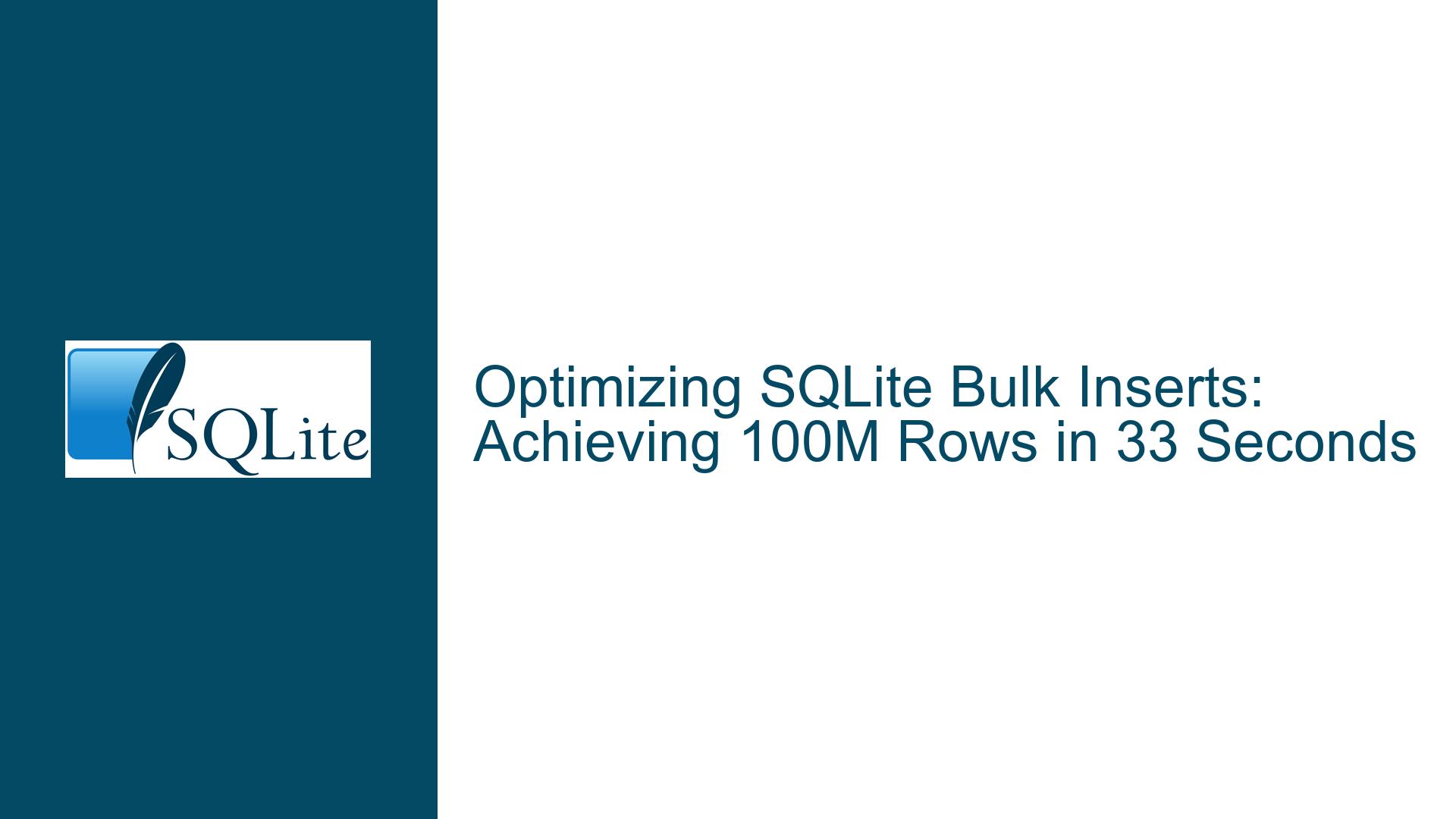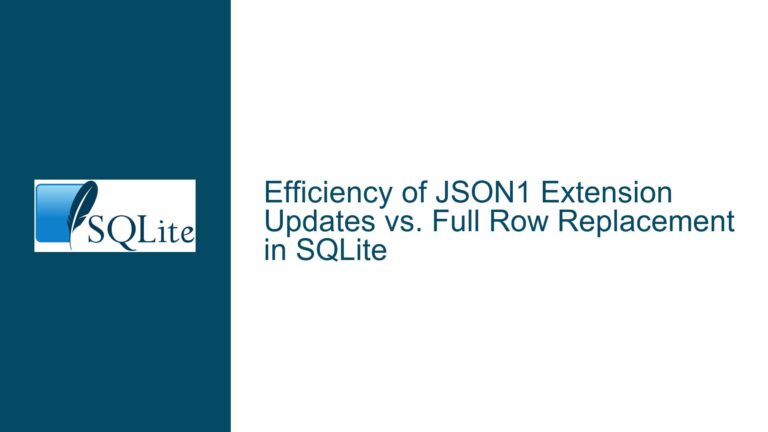Optimizing SQLite Bulk Inserts: Achieving 100M Rows in 33 Seconds
Performance Characteristics of High-Volume Row Insertion in SQLite
Issue Overview: Balancing Transaction Throughput and Hardware Limitations
The core challenge revolves around inserting 100 million rows into an SQLite database as quickly as possible while navigating the database engine’s design constraints and hardware limitations. The original poster (OP) achieved ~3 million rows per second using Rust with batched inserts, prepared statements, and aggressive PRAGMA configurations. However, they sought further optimizations, including multithreading and additional PRAGMA tuning. Key observations from their setup include:
- Schema Design: A simple table with three columns (
id INTEGER PRIMARY KEY,area CHAR(6),age INTEGER,active INTEGER). - Transaction Batching: Grouping inserts into transactions to minimize disk I/O.
- Prepared Statements: Reducing query parsing overhead.
- PRAGMA Settings: Disabling journaling (
journal_mode = OFF), settingsynchronous = 0, and increasingcache_sizeto reduce filesystem interactions. - Hardware Context: A mid-tier macOS system with an SSD, 8GB RAM, and a quad-core CPU.
The OP’s experiments revealed diminishing returns when increasing batch sizes beyond 100 rows and negligible gains from multithreading. Testing with an in-memory database (:memory:) showed no significant improvement, suggesting that the bottleneck had shifted from I/O to computational limits (e.g., SQLite’s internal rowid allocation or CPU-bound tasks).
Potential Bottlenecks in High-Speed Insertion Workflows
Several factors can throttle insertion performance in SQLite, even with optimal configurations:
Rowid Management:
SQLite automatically assigns arowidfor tables without anINTEGER PRIMARY KEY. Explicitly defining anINTEGER PRIMARY KEY(as the OP did) avoids therowidlookup, but generating unique keys in application code (e.g., via Rust) introduces overhead. SQLite’s internalrowidallocation is faster than application-level generation due to its sequential memory access pattern.Index Maintenance:
While the OP’s schema lacks secondary indexes, theINTEGER PRIMARY KEYitself is a clustered index. Every insertion requires updating this structure, which becomes computationally expensive at scale. UsingWITHOUT ROWIDtables or alternative indexing strategies (e.g., deferred index creation) can mitigate this.Page Size and Cache Efficiency:
SQLite’s default 4KB page size may not align with the SSD’s optimal write block size. Larger pages (e.g., 8KB or 16KB) reduce the number of I/O operations but increase fragmentation and read latency during subsequent operations.Transaction Boundaries:
Although the OP used batched transactions, the size of each batch (100 rows) may not fully exploit SQLite’s write-ahead log (WAL) or cache. Oversized batches risk exhausting memory, while undersized batches increase transaction commit overhead.Language and Driver Overhead:
The Rust implementation outperformed Python by ~4.5x due to lower-level memory management and reduced interpreter overhead. PyPy’s JIT compiler narrowed the gap but could not match native code.Filesystem Latency:
Even withsynchronous = 0andjournal_mode = OFF, the OS and SSD firmware impose latency constraints. In-memory databases eliminate this but require sufficient RAM to hold the entire dataset.
Comprehensive Optimization Strategies and Workarounds
1. PRAGMA Configuration Refinements
PRAGMA page_size = 8192or16384:
Increasing the page size reduces the number of pages written per transaction, aligning better with SSD block sizes (typically 4KB–16KB). Benchmark withPRAGMA page_sizebefore creating the database, as changing it post-creation requires aVACUUM.PRAGMA cache_size = -kibibytes:
A negative value sets the cache size in KiB (e.g.,-1000000allocates ~1GB). This ensures the cache size remains consistent regardless ofpage_size.PRAGMA mmap_size = N:
Memory-mapped I/O bypasses the filesystem cache, reducing copy operations. Setmmap_sizeto the database file size for direct memory access.
2. Schema and Index Adjustments
Defer Index Creation:
Create theINTEGER PRIMARY KEYcolumn without a constraint initially, then rebuild it post-insertion usingCREATE UNIQUE INDEX. This avoids incremental index updates during insertion.WITHOUT ROWIDTables:
Convert the table to aWITHOUT ROWIDformat if the primary key is non-integer or composite. This stores data in a B-tree structure, which can be faster for certain access patterns but may slow inserts due to key comparisons.Column Encoding:
UseBLOBfor composite data (e.g., packingarea,age, andactiveinto a single blob). This reduces per-row overhead from column headers and type checks.
3. Insertion Pipeline Optimization
Batched Multi-Row
INSERTStatements:
Use a singleINSERTstatement with multipleVALUESclauses (e.g.,INSERT INTO user VALUES (?,?,?), (?,?,?), ...). The OP achieved 33 seconds with 100-row batches, but larger batches (e.g., 500–1000 rows) may further reduce per-statement overhead. However, excessively large batches risk memory fragmentation.Parallel Data Generation:
Use producer-consumer threading to decouple data generation (e.g., random value creation) from insertion. A bounded SPSC (single-producer, single-consumer) queue prevents memory bloat and balances load between threads.Prepared Statement Reuse:
Reuse the same prepared statement across batches to avoid recompilation. The Rust code already does this, but Python’ssqlite3module may require explicitexecutemanycalls.
4. Filesystem and Hardware Tuning
RAM Disk or In-Memory Database:
Test with an in-memory database (:memory:) to establish a performance upper bound. The OP observed similar times for in-memory and SSD-backed databases, indicating CPU-bound processing.Direct I/O Bypass:
On Linux, mount the filesystem withO_DIRECTto bypass kernel caches. macOS lacks direct support, butfcntl(F_NOCACHE)can disable caching per file.SSD Over-Provisioning:
Ensure the SSD has sufficient free space (20–30%) to maintain write performance. Full SSDs suffer from garbage collection stalls.
5. Advanced Techniques
Virtual Tables:
Implement a custom virtual table that references in-memory data structures (e.g., Rust vectors). This eliminatesINSERTstatements entirely by exposing application data as a table.SQLite VFS Shims:
Develop a custom VFS (virtual filesystem) layer that batches writes or compresses data. This is complex but can reduce I/O volume.Offline Bulk Load:
Generate the database as a CSV or binary file, then import it using.importin the SQLite CLI with all optimizations enabled. This bypasses transactional overhead entirely.
Step-by-Step Fixes and Validation
1. Benchmark Baseline Performance
- Action: Measure current insert rates using
PRAGMA statsand OS-level tools (e.g.,iostat,vmstat). - Validation: Confirm whether the bottleneck is I/O (disk utilization near 100%) or CPU (high
usertime).
2. Optimize Page and Cache Sizes
- Action:
PRAGMA page_size = 16384; -- Set before table creation PRAGMA cache_size = -1000000; -- 1GB cache PRAGMA mmap_size = 1073741824; -- 1GB mmap - Validation: Monitor
systime reduction intimeoutput, indicating fewer filesystem calls.
3. Rebuild Indexes Post-Insert
- Action:
CREATE TABLE user_tmp (area CHAR(6), age INTEGER, active INTEGER); -- Insert all data into user_tmp CREATE TABLE user (id INTEGER PRIMARY KEY, area CHAR(6), age INTEGER, active INTEGER); INSERT INTO user SELECT NULL, area, age, active FROM user_tmp; DROP TABLE user_tmp; - Validation: Compare insertion times with and without deferred indexing.
4. Implement Producer-Consumer Threading
- Rust Example:
let (tx, rx) = bounded(1000); // Fixed-size queue let producer = thread::spawn(move || { for _ in 0..BATCHES { let batch = generate_batch(); // 100 rows tx.send(batch).unwrap(); } }); let consumer = thread::spawn(move || { let conn = Connection::open("test.db").unwrap(); conn.execute_batch("PRAGMA ...")?; let mut stmt = conn.prepare("INSERT ...")?; while let Ok(batch) = rx.recv() { stmt.execute(batch)?; } }); - Validation: Check CPU core utilization and memory footprint.
5. Evaluate In-Memory and Hybrid Workflows
- Action:
let conn = Connection::open_in_memory()?; // Insert data conn.backup(DatabaseName::Main, "test.db", None)?; - Validation: Compare insertion times and backup duration.
Conclusion
Achieving 3 million inserts/second in SQLite requires balancing transactional efficiency, schema design, and hardware capabilities. The OP’s approach is near-optimal for their hardware, with further gains likely requiring compromises like data compression or custom virtual tables. For most applications, however, the described optimizations (batched transactions, prepared statements, and aggressive PRAGMA settings) represent the practical limit of SQLite’s insert performance. Beyond this, scaling horizontally or migrating to a distributed database may be necessary.






